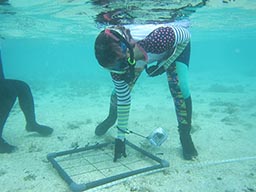- ABOUT US
- PROGRAM AREAS
- CONSERVATION APPROACH
- EDUCATION
- MULTIMEDIA
Jem Baldisimo: A Coral Reef Conservation Program 2025 Knauss Fellow

In February, the Coral Reef Conservation Program (CRCP) welcomed not one, but two Knauss Fellows for 2025. One of them is Jem Baldisimo, who is sponsored by Virginia Sea Grant and is finishing her PhD in Ecological Sciences from Old Dominion University. She received her bachelor’s degree in Environmental Science from Ateneo de Manila University, and her Master of Environment degree from the University of Melbourne.
Originally from the Philippines, Jem shared that her Filipino heritage and scenic country makes her inclined to protect marine resources (and to occasionally slay in karaoke). She saw the beauty of the environment from ‘ridge to reef’ after visiting the Philippines’ three apos (meaning elder or respected ancestor): Mount Apo, the country’s highest peak at 9,692 feet; Apo Island, where one of the longest running community-based marine sanctuaries in the world is located; and Apo Reef, the world’s second largest contiguous reef system. Her passion for the ocean led her to work in the private and non-profit sector as an environmental scientist and senior researcher, volunteer for a month-long citizen science reef monitoring program, and pursue a PhD in Ecological Sciences. After watching Finding Nemo as a college freshman, she is now helping fish like Nemo through her dissertation research where she uses different approaches like vulnerability scoring and genetic analyses to assess the extinction risk of fishes in the marine aquarium trade.

Prior to beginning her PhD, Jem was involved in creating the Philippine National Biodiversity Species Action Plan, and participated in the People and the Environment: Assessment of Reef-fish Resiliency and Associated Livelihoods (PEARRL) Project. The PEARRL Project aimed to assess the status of coral reef fishes and reef-associated livelihoods in the Philippines. This experience allowed her to travel, dive to survey reef fish biomass and abundance, and meet fishers across the country. She realized that those working to sustain marine resources should always consider not only the ecological and economic aspects, but also social dimensions. Communities are integral to the persistence of coral reefs. This strengthened Jem’s desire to contribute to the field of marine science and sustainable fisheries–after all, the Tagalog word for marine resources is yamang-dagat (meaning riches of sea). We must protect the ‘riches’ that the ocean provides us, including culture, heritage, livelihoods, and food security.

With her extensive experience in environmental management and coral reef fisheries in the Indo-Pacific region, Jem is looking forward to contributing to the CRCP’s mission to ‘conserve, and restore the nation's coral reefs by maintaining healthy ecosystem function’. Throughout the year, she will be supporting the U.S. Coral Reef Task Force and its various working groups, assisting in updating CRCP’s Programmatic Environmental Impact Statement, and contributing to CRCP’s social media channels.
Related Stories and Products
About Us

The NOAA Coral Reef Conservation Program was established in 2000 by the Coral Reef Conservation Act. Headquartered in Silver Spring, Maryland, the program is part of NOAA's Office for Coastal Management.

The Coral Reef Information System (CoRIS) is the program's information portal that provides access to NOAA coral reef data and products.
Work With US
U.S. Coral Reef Task Force
Funding Opportunities
Employment
Fellowship Program
Contracting Assistance
Graphic Identifier
Featured Stories Archive

Access the archive of featured stories here...
Feedback
Thank you for visiting NOAA’s Coral Reef Conservation Program online. Please take our website satisfaction survey. We welcome your ideas, comments, and feedback. Questions? Email coralreef@noaa.gov.
Stay Connected
Contact Us
NOAA’s Coral Reef Conservation Program
SSMC4, 10th Floor
1305 East West Highway
Silver Spring, MD 20910
coralreef@noaa.gov
